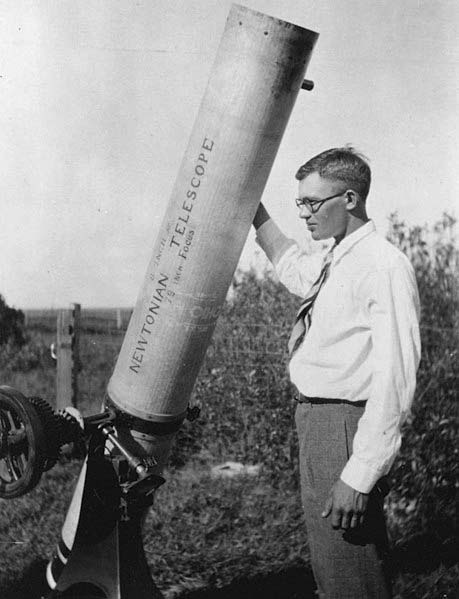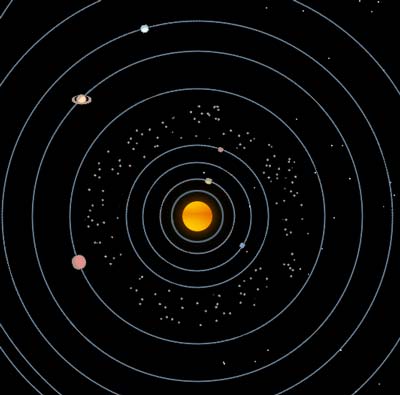The Demotion of Pluto
Only 8 Planets? What would Clyde have thought?
by Bill Georgevich
8/26/06
[A commentary by Astronomer Bill Georgevich on the decision to demote Pluto from planetary status]

Clyde Tombaugh
Photo credit: Public Domain
By Clyde, I mean Clyde Tombaugh, who discovered Pluto in 1930. I met Dr. Tombaugh in 1968 when I
was 16 years old. We were just about to land men on the moon, and the movie 2001 was inevitably preparing us to “enter Jupiter space” and begin manned exploration of the Solar system by the turn of the 20th century. The late 60s were heady times indeed for astronomy and space exploration.
I was introduced to Dr. Tombaugh “as the only living discoverer of a planet”, and the current Plutonian controversy actually began with it’s discovery when Tombaugh worked at Lowell Observatory in Flagstaff, Arizona.
Lowell itself has an interesting and infamous background, centered around the man himself, Mr. Percival Lowell, who decided to build his observatory for a very speical purpose. Son of a wealthy New England family,
he traveled west to Flagstaff to conduct a grand experiment to prove that there was indeed observable life on Mars. He commissioned for his Observatory one of the last great refracting telescopes to do one thing and one thing only. Observe Mars.
This was a time when fast photographic film was in its infancy, so unlike today, one could not take a picture of an object through a telescope, show it to his fellow astronomers, and compare notes. Lowell and his contemporaries were still drawing images while sitting at the telescope eyepiece–the same method Galileo used to draw the moons of Jupiter more than 200 years earlier. Those drawings almost got Galileo burned at the stake by the Catholic Church by challenging the geocentric model of the Solar System. So Lowell’s Martian drawings are not the first time an astronomer got in trouble for his sketches.
Percival Lowell’s obsession with Martian life was inspired by another Italian astronomer, Giovanni Schiaparelli, who first suggested the existence of canals on Mars. To Lowell, this untested theory was so grand and bold that it compelled him to pour his money, life, and resources into building his grand planetary observatory overlooking the frontier town of Flagstaff, Arizona.
Once complete, Lowell sat at his telescope for hours at a time, gazing relentlessly at Mars, and drawing features that he believed were irrigation canals that the Martians were using to grow food on their dry planet. For years, Lowell undertook this procedure with scientific diligence and growing hope and certainty that he was on the threshold of a great discovery.
Inevitably, the 1900’s brought an improvement in telescopes and photographic film speeds. Astronomers from other observatories put their powerful telescopes on Mars, but not one saw Lowell’s canals. His theory was widely renounced, and later more completely rejected when, in 1965, the unmanned Mars surveyors sent back pictures of Mars as a dry, cratered, barren planet. Lowell’s highly detailed and named Martian features of intelligent life became an object of great scientific and popular ridicule.
It was in this climate that a young man from Kansas was given the opportunity to use one of the smaller 13” telescopes at Lowell Observatory, to study another obsession of Lowell’s–an object known as Planet X.
Planet X caught the interest and imagination of astronomers because perturbations in the orbit of Neptune predicted another, undiscovered planetary body outside Neptune’s orbit. Clyde Tombaugh, the young budding astronomer from Kansas, came to Lowell and through the painstaking method of blink comparison, began to search for Planet X.
The blink comparison method allows a person to compare various photographic images taken of the exact same spot in the sky over time. If anything moved when you blinked from one plate to another it was not a “fixed star” but a planet, asteroid or maybe even a comet. Tombaugh took his photos night after night; developed them and day after day; looking for anything that moved.
Imagine the tedium of this painstaking work! A year and a half later Tombaugh noticed a tiny, featureless dot that was moving. That dot was Pluto.
When I studied under Tombaugh in 1968–nearly 40 years later–the professor’s hand-made blink comparitor was replaced with a brand new 3-million dollar scope from NASA. Its chief feature was a digital guidance system that allowed you locate any object in space by typing its name into a computer at the telescope. The scope would lock onto that object (and remain locked on, even as the earth rotated), without calibration of any kind. This was an amazing, cutting-edge technology for that time. (Today this feature is available on a $200 telescope at Costco.)
How Big a Deal is the planetary demotion of Pluto? What about rewriting textbooks, revamping Solar System models in classrooms & museums? In 1968, we had not landed anything on Mars and the Voyager spacecraft had not even visited Jupiter or Saturn. Yet even before Dr. Tomabaugh’s death in 1997, models of the Solar System had already been reworked once now showing rings around Uranus & Neptune not just Saturn like before. The Voyager destroyed Saturn’s primacy as the only ringed planet.
In the new 8 planet Solar System you’ll still see Pluto, it just won’t be labeled a planet. It will be part of a larger number of bodies that orbit the Sun outside the orbit of Neptune.
Would Clyde be personally disappointed that his planet has been demoted to a trans-Neptunian Kuiper Belt Object? I’ll answer this way:
After spending some time with Tombaugh back in the 60’s at the great new NASA scope that sat outside of Las Cruces, NM, I had the opportunity to visit him and his wife at home. In the backyard, he had a homemade telescope. A reflector of maybe 9” or 10” in diameter. He told me when he couldn’t get telescope time on the NASA scope he used his backyard scope. I asked him “Whatever for?”
He said, “I discovered Pluto with a 13-inch scope, film has gotten a lot better. Now I’m looking for the real Planet X-the tenth planet!” Clyde never found it, but he also never stopped looking. Which means that Clyde Tombaugh, like astronomical science itself, was always ready and excited about change.
 See an animation of the movement of planets in our solar system.
See an animation of the movement of planets in our solar system. See amazing views from space
See amazing views from space